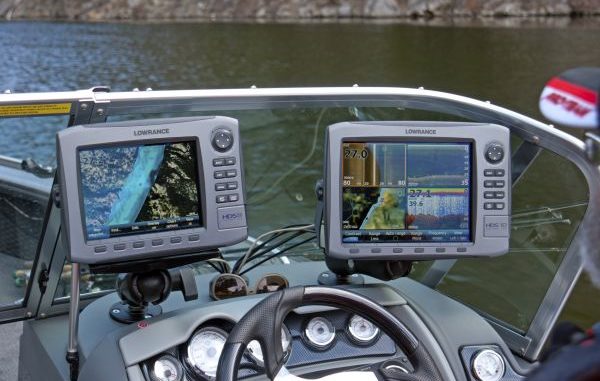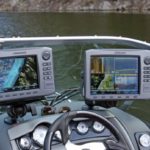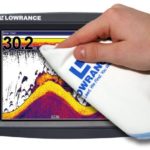
Dirty screens detract from fishing experience
Who hasn’t mistaken the shadow of a water spot on an LCD screen for a fish, waypoint or radar target? Or was it a smear of sunscreen lotion or insect repellent left by a fingertip? Hopefully it wasn’t a permanent scratch, crack, craze or other scar.
And the growing popularity of touch screens in marine electronics is increasing the hand-screen contact problem.
Protecting screens from temporary and permanent blemishes is easier and less expensive than removing them after the fact.
Trailering an open boat with the electronics installed exposes their screens to road grime, dirt, grit, tree branches, gravel and other flying objects. Snapping on their factory screen covers before hitting the road helps, but removing the units and transporting them in protective hard cases or padded bags works even better.
Wearing a small towel on your belt or hanging one near your helm seat gives you a place to wipe the excess sunscreen lotion, bug repellent, liquid fish attractant or residue from live or dead bait off your hands before touching your electronics.
Screens that have attracted a fine layer of sand, grit or other abrasive crud must be cleaned carefully to prevent permanent damage.
Wiping a dry rag over the grit turns the cloth into sandpaper, and you know what happens next.
Instead, pour or squirt clean water over the screen to flush away as much of the crud as possible, and then soak a clean rag until water runs out of it before touching it to a screen and gently mopping off the rest of the debris.
Use a light, even pressure on the cloth as you clean, and repeat as necessary.
Never press down hard on a small area of the display with fingers or the edge of your hand; concentrated pressure can flex the protective lens against the screen and might even damage pixels on the LCD.
Be extremely careful in choosing a cleaner when water isn’t enough to handle the cleanup. The protective lenses covering most LCD screens are made of some sort of plastic, not glass, and strong glass cleaners can permanently damage them.
Stay away from cleaners that include ammonia or other harsh chemicals not recommended for plastics and avoid anything abrasive.
I like Wilson Frazier’s Krystal Vision (www.itainttv.com) for use on my screens (and my sunglasses), but there are many kinds of liquid cleaners and wipes designed to safely do the job. Once again, make sure the product you choose is safe for use on plastics.
Small scratches that remain after a thorough cleaning can be removed with Meguiar’s Mirro Glaze Plastic Polish No. 17, available at auto parts stores and some marine dealers. I keep a clean, soft cloth wet with the polish, and move it under light pressure in a circular motion with each circle covering about half the screen.
This takes a while, and screen polishing is perhaps best done while watching the game or a movie on TV. Every 30 minutes or so I switch to a clean, dry cloth and gently wipe the screen dry so I can check on my scratch-removing progress.
Small scratches can be completely removed and the edges of deep scratches become rounded enough to make them all but disappear.
Adding a coat of another Meguiar’s product, Plastic Polish No. 10, to the screen forms a smooth, transparent layer that prevents most dirt and grit from sticking and lessens any abrasive damage when it does stick.
GPS units can also use a periodic screen decluttering done through their keypads or touchscreen controls.
Each generation of lake maps and marine charts seems to bring more detail to our screens. Lakes are being surveyed in 1-foot contours, and just these contour lines alone can clutter the screen at some range settings. More on-screen information about marinas, launching ramps, hazards to navigation and points of interest make both maps and charts look too busy.
We sometimes have to turn off non-critical layers of information just to make sense of the screen.
Track plot lines, waypoints and other user-generated markers contribute to the clutter.
Some of the track lines may be worth saving and naming, but some probably aren’t. I have even found man-overboard markers on my screens that I’d laid down quickly when someone’s hat blew off.
Tracks that mark safe passages through hazardous waters and those representing trolling passes that produced fish and probably will again should be saved and properly named. A proper name is one that will instantly connect your brain to the track when you see it on your list.
Names like “Striper Troll 1” or “Pass Thru Rocks” will make more sense to you a year after you record them than just “Track1” or “Track 2.”
And, even though they are saved, you can choose not to display them by turning them off through the menu system when you aren’t using them.
This is also a good time to recheck your waypoint list and rename any that could use more effective names. You can also change a waypoint’s on-screen icon to one that is more appropriate.
Any tracks, waypoints or other icons that represent temporary events that weren’t important enough to save are useless clutter and need to be deleted.
Clean, decluttered screens show just what you want to see in sharper detail and give you a better look at where you are and what you’re after.




